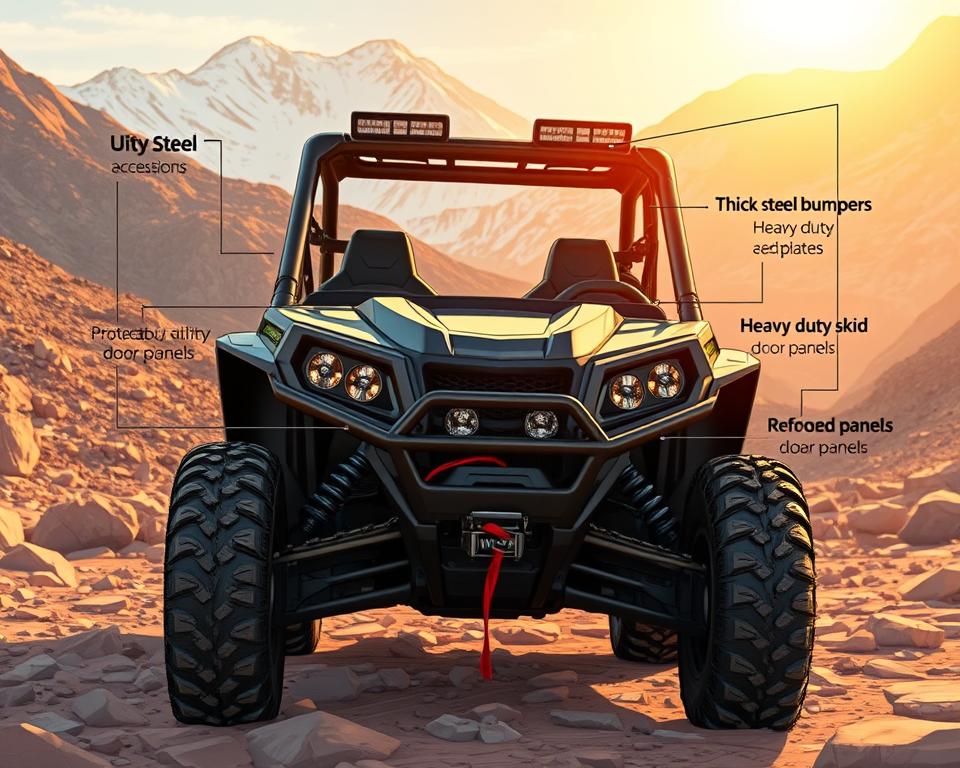Avoiding ATV/UTV Gearing Mistakes for Newbies
Surprisingly that nearly 35% of new ATV and UTV owners face gear selection issues within their first year? That figure highlights why beginners need to understand ATV gear ratios. Correct gear choice protects against accidents as well as enhances power. We’ll explore common mistakes, maintenance practices, and expert high lifters advice to improve your off-road adventures.
Critical Findings

- Knowing gear ratios is crucial for peak off-road power.
- Neglecting gearing details increases accident hazards.
- Routine care averts transmission breakdowns.
- Smart gear choices transform your outdoor rides.
- Applying service recommendations increases longevity.
Understanding ATV and UTV Gear Ratios
ATV/UTV gear ratios dictate how power meets torque. They govern both top speed and hauling capacity. This controls how quickly you get up to speed and tow trailers. Different gear ratios can transform a vehicle’s performance, making it better suited for racing, off-road driving, or towing.
Selecting proper gears unlocks engine potential. Too low a ratio may leave you underpowered on inclines. Overgearing sacrifices quickness for top-end speed.
Adjusting reduction influences handling in mud, sand, and rock. By adjusting gear ratios, riders can customize their vehicle’s performance. It perfectly aligns performance with your riding style. Optimal ratios deliver smoother use and better MPG.
Common Gearing Oversights for New ATV/UTV Owners
Proper gear choice underpins both power and protection. Many new owners overlook critical aspects of gear selection. Understanding the effects of wrong gear choices and selecting the right one for your terrain can greatly improve your ride. Plus, it prevents mechanical setbacks.
Impact of Incorrect Gear Selection
Choosing the wrong gear can lead to serious problems, including loss of control and mechanical failures. Poor gear choice dampens speed, stresses brakes, and accelerates wear. Such errors endanger everyone, from driver to bystanders. Following key ATV maintenance tips can help avoid these issues.
Choosing the Right Gear for Terrain
Each surface demands its own ratio. For steep hills, lower gears provide better torque and control. To cover ground quickly, shift to higher ratios. Soft ground demands careful gear choice for grip. Recognizing terrain traits delivers safer, smoother rides.
The Importance of Proper ATV Maintenance
Routine upkeep ensures reliable performance. Adhering to care guides prevents sudden failures and enhances safety. A smart maintenance regimen targets gearbox longevity.
Regular Inspection and Maintenance
A detailed inspection checklist is essential for spotting issues early. It’s important to check gears, brakes, tires, and belts regularly. Routine checks lead to peak performance. Here are some critical inspection points to remember:
- Examine gear alignment and wear.
- Ensure all fasteners are tight.
- Inspect brake lines and levels.
- Verify tire PSI and rubber life.
- Review electrical systems for corrosion.
Fluid Changes and Gear Health
Clean fluids keep transmissions and differentials happy. Routine fluid swaps avoid sludge and varnish. Pure coolant and oil lower temperatures and prolong service intervals. Using this method secures dependable function and fewer breakdowns.
| Fluid Type | Recommended Change Interval | Benefits of Regular Change |
|---|---|---|
| Motor Oil | 50–100 operating hours | Reduces engine wear, enhances performance |
| Gear Oil | Every 100-200 hours | Improves shifting, minimizes gear damage |
| Antifreeze | Once per year | Prevents overheating, maintains optimal temperature |
Sticking to this plan ensures uninterrupted trail fun. This makes every journey more enjoyable.
Common ATV Gear Shifting Problems
Rookie riders struggle with smooth shifts. Mastering smooth shifting techniques can greatly improve the riding experience. It reduces frustration on the trails. Proper coordination of the throttle and clutch is key for control and avoiding shifting problems.
Learning to Shift Smoothly
Building graceful shift habits demands consistent effort. First, feel your engine’s rev pattern. Careful engagement protects internals and stops wear. Matching revs while you let out the clutch is essential.
Practice shifting in a controlled setting until you’re confident. Keep your throttle light when shifting.
Recognizing Signs of Gear Issues
Early detection of gear issues is essential. Listen for unusual sounds like grinding or popping, which may mean gears aren’t engaging right. Hard shifts or missed gears indicate trouble. Fixing problems fast keeps you safer on the trail. Addressing ATV gear shifting problems properly maintains vehicle performance and boosts your confidence while riding.
Understanding UTV Transmission Issues
UTV gearbox troubles challenge many owners, so familiarity helps diagnose. Owners often face issues like slipping gears or odd noises. Here we examine usual faults and outline a step-by-step fix plan. Drawing on proven UTV repair protocols.
Diagnosing Common Problems
Identifying symptoms early prevents bigger issues. Common issues include:
- Slipping gears that threaten control and safety.
- Unusual sounds, such as grinding or whining, indicating mechanical damage.
- Signs of fluid seepage that threaten gearbox health.
Regular gear diagnostics help spot these issues quickly. You can then address issues swiftly. Missing early clues damages your ride and wallet.
Solutions for Troubleshooting UTV Transmissions
Solving drivetrain faults depends on a structured routine. Follow these steps for effective troubleshooting:
- Check fluid levels and top up if necessary.
- Look for wet spots beneath the transmission.
- Assess internal components for wear or chipping.
- Drive through each gear step-by-step and note any skips.
- Consult the owner’s manual for specific diagnostics related to your model.
Leveraging a proven guide speeds up repairs. Understanding gear mechanics is key for any UTV owner. That insight preserves reliability and output.
ATV Clutch Adjustments and Their Benefits
Accurate clutch tuning unlocks seamless shifts. Misadjusted clutches cause jerky shifts and rider irritation. Frequent tuning enhances clutch grip and shift precision.
Precision in gear changes is critical. Correctly calibrated clutches enable flawless transitions. It refines acceleration and comfort across all conditions.
Ignoring clutch adjustments can harm performance and wear out parts. Consistent adjustments sustain peak clutch function. It’s critical for both new and seasoned riders to ensure their ATV performs at its best.
Mastering the Art of Gear Shifting
Excelling at transitions elevates your trail adventures. Understanding drivetrain function and shift timing is crucial. Novices must learn shift cadence. A comfortable cadence leads to smoother transitions and improved performance.
Smooth shifts arise from varied-condition training. Knowing shift points for hills, flats, and mud secures handling. Downshifting into grades safeguards momentum and balance.
- Rehearse clicks slowly to gain control.
- Note engine tone and drivetrain reaction.
- Gradually incorporate more challenging terrains to test your skills.
Getting in sync with your ride ensures perfect shifts. Listen for pitch changes and shudders to guide engagements. Such feedback tells you when to execute transitions. That instinctive skill yields seamless shifts and more fun.
Best Practices for UTV Gear Selector Problems
Resolving gear lever faults requires regular inspection and testing. Regular inspections are key to spotting issues early. Learning proper lever use minimizes failures. Check shifter arms and oil levels with each maintenance session.
When facing gear selector issues, first check the selector mechanism for obstructions or damage. Squeaks might indicate misalignment. Simple adjustments and cleaning often solve issues without needing major repairs. A routine plan stops small faults from growing.
Using a systematic approach, like documenting gear performance under different conditions, helps identify specific problems. Following these methods preserves selector health and rider trust.
Tips for Enhancing Gear Performance
Maintaining optimal gear performance requires a proactive approach. Regular maintenance is key to improving ATV efficiency. It’s important to check fluid levels, inspect for wear, and adjust settings as needed. Spotting wear early stops expensive overhauls.
Picking ideal ratios unlocks quicker revs and seamless cruisin’. Assessing ground conditions guides your ratio picks. It influences your launch and maximum velocity. Seeking parts from specialists such as American Off-Roads aids in UTV performance enhancements.
Implementing gear performance tips in wheels, springs, and ballast optimization elevates function. These tweaks guarantee superior handling in rough conditions. Your rides become more fun and less fatiguing. By using these methods, you’ll tackle trails boldly and relish every moment.
In Closing
Mastering ATV/UTV gearing is essential for performance and safety. Selecting proper ratios for each trail elevates your experience. By avoiding common mistakes and making smart choices, your off-road trips will be both fun and secure.
The importance of performance maintenance cannot be overstated. Scheduled maintenance and TLC save you from breakdowns and prolong service. Good upkeep maximizes output and secures your rides in all conditions.
Merging smart ratio choice and regular upkeep yields the best off-road enjoyment. Following these guidelines paves the way for endless trail excitement.
FAQ
Standard gear ratios on off-road rigs?
ATVs and UTVs have gear ratios that vary widely, depending on the model. They usually range from 3:1 to 5:1. Smaller ratios deliver grunt for trails and climbs. Higher ratios, on the other hand, can increase top speed on flat terrain.
How to spot unsuitable gearing?
Using the wrong gear can lead to loss of control, excessive engine revving, or poor acceleration. Mud, sand, rocks, and snow each call for tailored gear choices.
What are some signs that my ATV/UTV needs maintenance?
Look out for signs like difficulty shifting gears, unusual noises from the transmission, fluid leaks, or a decrease in performance. Scheduling drivetrain inspections stops big failures.
How often should I change the fluids in my ATV/UTV gear system?
Aim for a fluid swap between 1,500–2,500 miles or annually, whichever comes first. Fresh fluids promote crisp shifts and gearbox longevity.
Best practices for flawless shifts?
For smooth gear shifting, practice coordinating the throttle and clutch. Gradually release the clutch while pressing the throttle to match engine speed with wheel speed.
Steps to diagnose gearbox problems?
Begin with fluid level checks and a listen for whines or grinds. Verify oil clarity and fill. Next, test-drive at varied speeds to see how it shifts.
Why adjust your ATV clutch?
Proper clutch adjustments are essential for smooth gear transitions. Bad clutch alignment wears out parts prematurely and hinders shifts.
Adapt gearing for every surface?
Test multiple gearing options and look into quality mods by American Off-Roads. Scheduled service—linkage grease and oil changes—maintains top output.
When your UTV shifter sticks?
Regular inspections and routine maintenance are key. When the shifter binds, use the OEM troubleshooting procedures to find the root cause.
Rookie gearing errors to dodge?
Beginners sometimes skip ratio learning, skip services, or stay in the wrong gear for conditions. Such errors cause subpar power delivery and increased accident risk.


